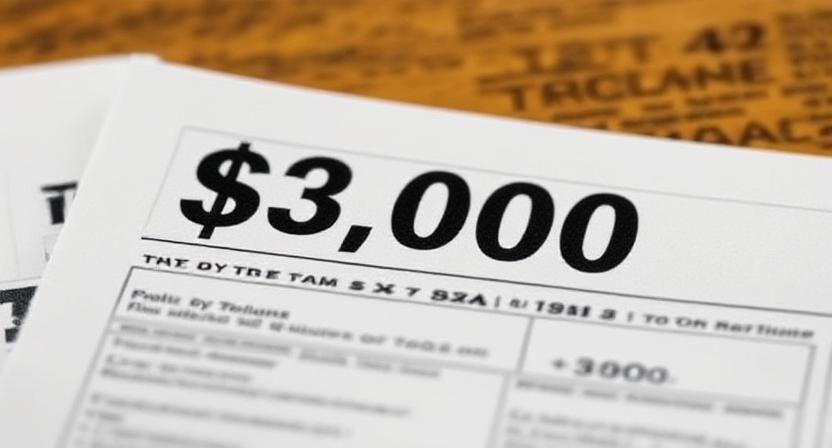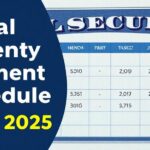Many Americans are talking about the $3000 IRS tax refund in 2025. But what does it mean? Is it real? And most importantly, how do you get it?
This post breaks it down in plain language. You’ll learn how to claim the $3000 IRS tax refund in 2025, who can get it, and what steps you need to take.

What Is the $3000 IRS Tax Refund?
The $3,000 IRS tax refund is not a new program or stimulus. It is the average amount people are getting back after filing their 2024 taxes in early 2025. The IRS has reported that most refunds are close to $2,945, and some are even higher.
This refund is money that was overpaid in taxes during 2024. It comes from paycheck withholdings, refundable tax credits, or other overpayments.

So, if you worked in 2024 and paid more than you owed in taxes, you could get your money back. That’s what the IRS tax refund is all about.
Who Can Get This Refund?
Not everyone gets the same refund. Some get more, some get less. To know how to claim the $3000 IRS tax refund in 2025, you must first see if you qualify.
Here’s what you need:
- You filed your 2024 federal tax return
- You had earned income in 2024
- You paid federal taxes through your job or self-employment
- You have a valid Social Security Number
- You may have claimed tax credits like the Child Tax Credit or the Earned Income Tax Credit (EITC)
If you didn’t owe much in taxes but had credits or overpayments, you’re likely to get a refund. And if you fit the average, it could be close to $3,000.
How to Claim the $3000 IRS Tax Refund in 2025
Now let’s go step by step. Here’s how to claim the $3000 IRS tax refund in 2025 if you haven’t filed yet or want to make sure you get it right.
Step 1: File Your 2024 Federal Tax Return
This is the first and most important step. You must file your tax return. The IRS won’t send your refund unless you do.
You can file:
- Online (e-file)
- Through a tax preparer
- Or by mailing paper forms (this is slower)
E-filing is the fastest and easiest way.
Step 2: Use Direct Deposit
Always choose direct deposit to get your refund. This sends the money straight to your bank account. It’s faster and safer than getting a paper check.
Make sure you enter the correct account number and routing number when filing.
Step 3: Check for Refundable Credits
Some tax credits can boost your refund. These include:
- Child Tax Credit (CTC)
- Earned Income Tax Credit (EITC)
- American Opportunity Tax Credit (for college students)
If you qualify for these, your refund could be bigger — maybe even over $3,000.
Step 4: Double-Check Your Return
Errors cause delays. Before you submit, review your form. Make sure:
- All numbers are correct
- Your name and SSN match your records
- You included all income and documents
This will help avoid problems and get your refund faster.
Step 5: File As Early As You Can
The sooner you file, the sooner you get your refund. Filing early also helps prevent tax fraud.
The IRS began processing 2024 returns in January 2025. If you file by mid-May, you’ll likely get your refund by early June.
When Will You Get Your Refund?
Here’s a quick look at estimated refund dates for 2025:
Filed DateRefund (Direct Deposit)Refund (Paper Check)
April 15 – May 1 May 8 – May 22 May 29 – June 12
May 1 – May 15 May 22 – June 4 June 12 – June 26
May 15 – May 31 June 4 – June 18 June 26 – July 10
These dates are estimates based on past data. Delays can happen, especially if you file by mail or have issues with your return.
Why Refunds Can Be Delayed
Sometimes, refunds don’t arrive on time. Here are common reasons why:
- Your return had errors
- Your identity needs to be verified
- You mailed a paper return
- You claimed certain credits that need extra checks
- Your bank info was incorrect
To avoid this, e-file early, check your return, and use direct deposit.
How to Track Your Refund
Want to see where your refund is?
Use the IRS tool called “Where’s My Refund?”
You’ll need:
- Your Social Security Number
- Your filing status (single, married, etc.)
- Your exact refund amount
This tool shows your refund status in three stages:
- Return Received
- Refund Approved
- Refund Sent
You can also use the IRS2Go app on your phone.
What If You Haven’t Filed Yet?
If you haven’t filed your 2024 taxes yet, you can still do it. The deadline was in April, but late returns are allowed. Just know that if you owe taxes, you may pay a penalty for being late.
But if you’re due a refund, you can still claim it without penalty — just don’t wait too long. The IRS gives you up to three years to claim a refund.
Tips to Get Your Refund Without Problems
Want to make the process easy? Here are quick tips:
- File online
- Choose direct deposit
- Double-check your info
- Use a trusted tax tool or a pro
- File early to avoid delays
These simple steps help you claim the $3000 IRS tax refund in 2025 without issues.
Why This Refund Matters
Getting a $3,000 refund can help you pay bills, cover rent, or save for later. It’s your money, not a handout.
This refund is the extra amount you paid last year. By filing your taxes the right way, you get it back.
Final Thoughts
To sum it up:
- The $3000 IRS refund is the average amount people are getting in 2025
- You must file your 2024 federal tax return to claim it
- File early, use direct deposit, and check your return for errors
- Track your refund using the IRS tools
It’s simple if you follow the right steps.
Now that you know how to claim the $3000 IRS tax refund in 2025, don’t wait. File your return, and get your money back.
FAQs About the $3000 IRS Tax Refund
1. Is the $3000 refund real?
Yes. It’s not a bonus or a new program. It’s the average tax refund from overpaid taxes in 2024.
2. How do I claim the $3000 IRS tax refund in 2025?
File your 2024 federal tax return, choose direct deposit, and include all required info.
3. Can I still get the refund if I file late?
Yes, but file as soon as possible. If you’re due a refund, there’s no penalty for filing late.
4. How long does it take to get the refund?
Most refunds take 21 days after e-filing. Paper returns can take 6 to 8 weeks.
5. What if I didn’t earn much in 2024?
You might still get a refund if you qualify for tax credits. File your return to find out.
6. Is this refund the same as a stimulus check?
No. This is not a stimulus. It’s a regular tax refund based on what you overpaid.
7. Where can I check my refund status?
Go to irs.gov/refunds and use the “Where’s My Refund?” tool.





